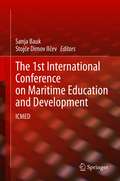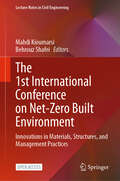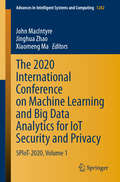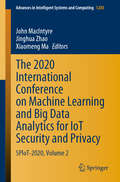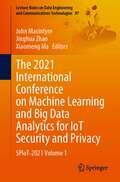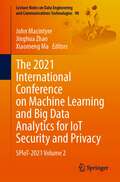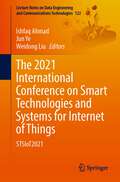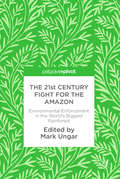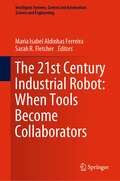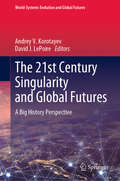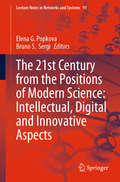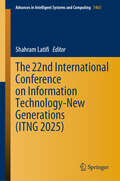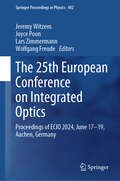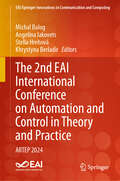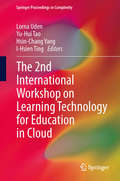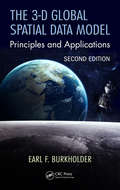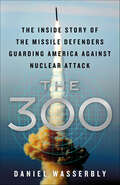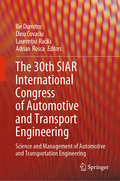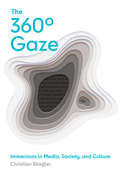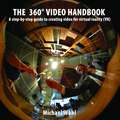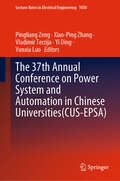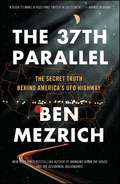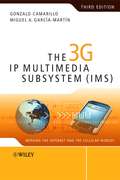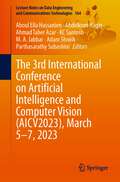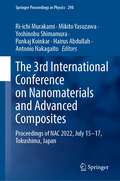- Table View
- List View
The 1st International Conference on Maritime Education and Development: ICMED
by Stojče Dimov Ilčev Sanja BaukThis book presents the proceedings of the 1st International Conference on Maritime Education and Development. The conference exchanges knowledge, experiences and ideas in the domain of maritime education and development, with the ultimate goal of generating new knowledge and implementing smart strategies and actions. Topics include the 4th Industrial Revolution (4IR); unmanned air/sea surface/underwater vehicles (UxV); the digital divide and Internet accessibility; digital infrastructure; IMO E-navigation strategy; smart-ship concept; automation and digitalization; cyber security; and maritime future. This proceedings pertains to researchers, academics, students, and professionals in the realm of maritime education and development.
The 1st International Conference on Net-Zero Built Environment: Innovations in Materials, Structures, and Management Practices (Lecture Notes in Civil Engineering #237)
by Mahdi Kioumarsi Behrouz ShafeiThis open access book provides the latest fundamental and practical advances in reducing the built environment’s carbon footprint based on a collection of papers presented at the 1st International Conference on Net-Zero Built Environment: Innovations in Materials, Structures, and Management Practices, held June 19-21, 2024, in Oslo, Norway. The volume presents research investigations and case studies spanning five interrelated domains: New materials and material preparation processes for zero (or negative) carbon footprint Robotic construction technologies for minimum formwork and on-site activities Novel structural designs and details for optimal performance with the least material usage Advanced condition assessment and health monitoring methods for the longest service life Innovative life-cycle analysis and policy-making strategies for effective civil infrastructure management
The 2020 International Conference on Machine Learning and Big Data Analytics for IoT Security and Privacy: SPIoT-2020, Volume 1 (Advances in Intelligent Systems and Computing #1282)
by John MacIntyre Jinghua Zhao Xiaomeng MaThis book presents the proceedings of The 2020 International Conference on Machine Learning and Big Data Analytics for IoT Security and Privacy (SPIoT-2020), held in Shanghai, China, on November 6, 2020. Due to the COVID-19 outbreak problem, SPIoT-2020 conference was held online by Tencent Meeting. It provides comprehensive coverage of the latest advances and trends in information technology, science and engineering, addressing a number of broad themes, including novel machine learning and big data analytics methods for IoT security, data mining and statistical modelling for the secure IoT and machine learning-based security detecting protocols, which inspire the development of IoT security and privacy technologies. The contributions cover a wide range of topics: analytics and machine learning applications to IoT security; data-based metrics and risk assessment approaches for IoT; data confidentiality and privacy in IoT; and authentication and access control for data usage in IoT. Outlining promising future research directions, the book is a valuable resource for students, researchers and professionals and provides a useful reference guide for newcomers to the IoT security and privacy field.
The 2020 International Conference on Machine Learning and Big Data Analytics for IoT Security and Privacy: SPIoT-2020, Volume 2 (Advances in Intelligent Systems and Computing #1283)
by John MacIntyre Jinghua Zhao Xiaomeng MaThis book presents the proceedings of The 2020 International Conference on Machine Learning and Big Data Analytics for IoT Security and Privacy (SPIoT-2020), held in Shanghai, China, on November 6, 2020. Due to the COVID-19 outbreak problem, SPIoT-2020 conference was held online by Tencent Meeting. It provides comprehensive coverage of the latest advances and trends in information technology, science and engineering, addressing a number of broad themes, including novel machine learning and big data analytics methods for IoT security, data mining and statistical modelling for the secure IoT and machine learning-based security detecting protocols, which inspire the development of IoT security and privacy technologies. The contributions cover a wide range of topics: analytics and machine learning applications to IoT security; data-based metrics and risk assessment approaches for IoT; data confidentiality and privacy in IoT; and authentication and access control for data usage in IoT. Outlining promising future research directions, the book is a valuable resource for students, researchers and professionals and provides a useful reference guide for newcomers to the IoT security and privacy field.
The 2021 International Conference on Machine Learning and Big Data Analytics for IoT Security and Privacy: SPIoT-2021 Volume 1 (Lecture Notes on Data Engineering and Communications Technologies #97)
by John Macintyre Jinghua Zhao Xiaomeng MaThis book presents the proceedings of the 2020 2nd International Conference on Machine Learning and Big Data Analytics for IoT Security and Privacy (SPIoT-2021), online conference, on 30 October 2021. It provides comprehensive coverage of the latest advances and trends in information technology, science and engineering, addressing a number of broad themes, including novel machine learning and big data analytics methods for IoT security, data mining and statistical modelling for the secure IoT and machine learning-based security detecting protocols, which inspire the development of IoT security and privacy technologies. The contributions cover a wide range of topics: analytics and machine learning applications to IoT security; data-based metrics and risk assessment approaches for IoT; data confidentiality and privacy in IoT; and authentication and access control for data usage in IoT. Outlining promising future research directions, the book is a valuable resource for students, researchers and professionals and provides a useful reference guide for newcomers to the IoT security and privacy field.
The 2021 International Conference on Machine Learning and Big Data Analytics for IoT Security and Privacy: SPIoT-2021 Volume 2 (Lecture Notes on Data Engineering and Communications Technologies #98)
by John Macintyre Jinghua Zhao Xiaomeng MaThis book presents the proceedings of the 2020 2nd International Conference on Machine Learning and Big Data Analytics for IoT Security and Privacy (SPIoT-2021), online conference, on 30 October 2021. It provides comprehensive coverage of the latest advances and trends in information technology, science and engineering, addressing a number of broad themes, including novel machine learning and big data analytics methods for IoT security, data mining and statistical modelling for the secure IoT and machine learning-based security detecting protocols, which inspire the development of IoT security and privacy technologies. The contributions cover a wide range of topics: analytics and machine learning applications to IoT security; data-based metrics and risk assessment approaches for IoT; data confidentiality and privacy in IoT; and authentication and access control for data usage in IoT. Outlining promising future research directions, the book is a valuable resource for students, researchers and professionals and provides a useful reference guide for newcomers to the IoT security and privacy field.
The 2021 International Conference on Smart Technologies and Systems for Internet of Things: STSIoT2021 (Lecture Notes on Data Engineering and Communications Technologies #122)
by Weidong Liu Jun Ye Ishfaq AhmadThis book contains papers presented at the 2021 International Conference on Smart Technologies and Systems for Internet of Things, held on November 26–27, 2021, in Shanghai, China. It covers topics like distributed processing for sensor data in CPS networks, approximate reasoning and pattern recognition for CPS networks, distributed processing in mobile networking, data analytics for social media sensor data integration, data platforms for efficient integration with CPS networks, virtualized and cloud-oriented resources for data processing for CPS networks, machine learning algorithms for CPS networks, data security and privacy in CPS networks, sensor fusion algorithms, sensor signal processing, data acquisition and preprocessing technology, intelligent computing, data mining methods and algorithms, big data system solutions and tools platform, intelligent control and intelligent management, and operational situation awareness utilizing big data-driven intelligence. It caters to postgraduate students, researchers, and practitioners specializing and working in related areas.
The 21st Century Fight for the Amazon
by Mark UngarThis book is the most updated and comprehensive look at efforts to protect the Amazon, home to half of the world's remaining tropical forests. In the past five years, the Basin's countries have become the cutting edge of environmental enforcement through formation of constitutional protections, military operations, stringent laws, police forces, judicial procedures and societal efforts that together break through barriers that have long restrained decisive action. Even such advances, though, struggle to curb devastation by oil extraction, mining, logging, dams, pollution, and other forms of ecocide. In every country, environmental protection is crippled by politics, bureaucracy, unclear laws, untrained officials, small budgets, regional rivalries, inter-ministerial competition, collusion with criminals, and the global demand for oils and minerals. Countries are better at creating environmental agencies, that is, than making sure that they work. This book explains why, with country studies written by those on the front lines--from national enforcement directors to biologists and activists.
The 21st Century Industrial Robot: When Tools Become Collaborators (Intelligent Systems, Control and Automation: Science and Engineering #81)
by Maria Isabel Aldinhas Ferreira Sarah R. FletcherThis book aims to discuss the technical and ethical challenges posed by the present technological framework and to highlight the fundamental role played by human-centred design and human factors in the definition of robotic architectures for human–robot collaboration.The book gives an updated overview of the most recent robotic technology, conceived and designed to collaborate with human beings in industrial working scenarios. The technological development of robotics over the last years and the fast evolution of AI, machine learning and IoT have paved the way for applications that extend far beyond the typical use of robots performing repetitive tasks in exclusive spaces. In this new technological paradigm that is expected to drive the robotics market in the coming years, robots and workers will coexist in the same workplace, sharing not only this lived space, but also the roles and functions inherent to a process of production, merging the benefits of automated and manual performing. However, having robots cooperating in real time with workers, responding in a physical, psychological and social adequate way, requires a human-centred design that not only calls for high safety standards regulating the quality of human–robot interaction, but also demands the robot's fine-grained perception and awareness of the dynamics of its surrounding environment, namely the behaviours of their human peers—their expected actions/responses—fostering the necessary collaborative efforts towards the accomplishment of the tasks to be executed.
The 21st Century Singularity and Global Futures: A Big History Perspective (World-Systems Evolution and Global Futures)
by Andrey V. Korotayev David J. LePoireThis book introduces a 'Big History' perspective to understand the acceleration of social, technological and economic trends towards a near-term singularity, marking a radical turning point in the evolution of our planet. It traces the emergence of accelerating innovation rates through global history and highlights major historical transformations throughout the evolution of life, humans, and civilization. The authors pursue an interdisciplinary approach, also drawing on concepts from physics and evolutionary biology, to offer potential models of the underlying mechanisms driving this acceleration, along with potential clues on how it might progress. The contributions gathered here are divided into five parts, the first of which studies historical mega-trends in relation to a variety of aspects including technology, population, energy, and information. The second part is dedicated to a variety of models that can help understand the potential mechanisms, and support extrapolation. In turn, the third part explores various potential future scenarios, along with the paths and decisions that are required. The fourth part presents philosophical perspectives on the potential deeper meaning and implications of the trend towards singularity, while the fifth and last part discusses the implications of the Search for Extraterrestrial Intelligence (SETI). Given its scope, the book will appeal to scholars from various disciplines interested in historical trends, technological change and evolutionary processes.
The 21st Century from the Positions of Modern Science: Intellectual, Digital and Innovative Aspects (Lecture Notes in Networks and Systems #91)
by Elena G. Popkova Bruno S. SergiThese proceedings gather the best papers presented at the “10th International Scientific and Practical Conference – the 21st Century from the Positions of Modern Science: Intellectual, Digital and Innovative Aspects,” which was organized by the non-profit organization “Institute of Scientific Communications.” The conference took place on May 23–24 in Nizhny Novgorod, Russia, with support from Minin Nizhny Novgorod State Pedagogical University. The chief advantage of these proceedings are their multidisciplinary character – they include articles and empirical studies addressing various fields, including economics, the social sciences, and law. Accordingly, the target audience is broad, covering scholars, researchers, independent experts, entrepreneurs, and government workers, who are interested in issues concerning: measuring and accelerating socio-economic development; the formation and evolution of the digital society and digital economy; the role of economic systems and economic subjects in the 21st-century technological revolution (the fourth industrial revolution); development and implementation of AI; development and application of intellectual resources in economic activities; and innovations in the economy.
The 22nd International Conference on Information Technology-New Generations (Advances in Intelligent Systems and Computing #1463)
by Shahram LatifiThis book covers technical contributions that have been submitted, reviewed and presented at the 22nd annual event of International conference on Information Technology: New Generations (ITNG) The applications of advanced information technology to such domains as astronomy, biology, education, geosciences, security and health care are among topics of relevance to ITNG. Visionary ideas, theoretical and experimental results, as well as prototypes, designs, and tools that help the information readily flow to the user are of special interest. Machine Learning, Robotics, High Performance Computing, and Innovative Methods of Computing are examples of related topics.
The 25th European Conference on Integrated Optics: Proceedings of ECIO 2024, June 17–19, Aachen, Germany (Springer Proceedings in Physics #402)
by Jeremy Witzens Joyce Poon Lars Zimmermann Wolfgang FreudeThis volume presents peer-reviewed and selected papers from the 2024 European Conference on Integrated Optics (ECIO), held on 17-19 June, 2024, and organized by RWTH Aachen University, Germany, in collaboration with Max-Planck Institute of Microstructure Physics, Technical University of Berlin, Leibniz Institute for High Performance Microelectronics, and Karlsruhe Institute of Technology. In the 25th edition of this conference, internationally recognized experts share their latest research and showcase their products and services in the field of integrated optics, optoelectronics, and nano-photonics. The conference focuses on leading-edge research and its broad application scope ranges from tele/datacom, optical interconnects, and (bio) optical sensing to more disruptive areas such as quantum computing and programmable photonics.
The 2nd EAI International Conference on Automation and Control in Theory and Practice: ARTEP 2024 (EAI/Springer Innovations in Communication and Computing)
by Michal Balog Angelina Iakovets Stella Hrehová Khrystyna BerladirThis book presents the proceedings of the EAI International Conference on Automation and Control in Theory and Practice (ARTEP 2024), held in Orechová Potôň, Slovakia, February 7-9, 2024. The aim of the conference was to meet the experts in the field of control, industrial automation and ICT in the industry from universities, colleges, and practice. The conference aims to draw attention to modern trends in the field, to enable experts, pedagogues and scientific researchers to present the results achieved in their work, to exchange experiences and establish working contacts between meeting participants. The ARTEP proceedings includes papers on automation and control and their integration of technologies such as Industry 4.0, robotics, and IoT. ARTEP is primarily a conference for scientists and practitioners who develop and study automation, management, and technologies.
The 2nd International Workshop on Learning Technology for Education in Cloud
by Lorna Uden I-Hsien Ting Hsin-Chang Yang Yu-Hui TaoProceedings from the 2013 LTEC conference in Kaohsiung, Taiwan. The papers examine diverse aspects of Learning Technology for Education in Cloud environments, including social, technical and infrastructure implications. Also addressed is the question of how cloud computing can be used to design applications to support real time on demand learning using technologies. The workshop proceedings provide opportunities for delegates to discuss the latest research in TEL (Technology Enhanced Learning) and its impacts for learners and institutions, using cloud technologies.
The 3-D Global Spatial Data Model: Principles and Applications, Second Edition
by Earl F. BurkholderTraditional methods for handling spatial data are encumbered by the assumption of separate origins for horizontal and vertical measurements, but modern measurement systems operate in a 3-D spatial environment. The 3-D Global Spatial Data Model: Principles and Applications, Second Edition maintains a new model for handling digital spatial data, the global spatial data model or GSDM. The GSDM preserves the integrity of three-dimensional spatial data while also providing additional benefits such as simpler equations, worldwide standardization, and the ability to track spatial data accuracy with greater specificity and convenience. This second edition expands to new topics that satisfy a growing need in the GIS, professional surveyor, machine control, and Big Data communities while continuing to embrace the earth center fixed coordinate system as the fundamental point of origin of one, two, and three-dimensional data sets. Ideal for both beginner and advanced levels, this book also provides guidance and insight on how to link to the data collected and stored in legacy systems.
The 300: The Inside Story of the Missile Defenders Guarding America Against Nuclear Attack
by Daniel WasserblyMilitary and security expert Daniel Wasserbly introduces the elite unit tasked with protecting the nation from long-range weapons of mass destruction.Comprised of just three hundred soldiers, the United States Army’s 100th Missile Defense Brigade and 49th Missile Defense Battalion utilize sophisticated and cutting-edge technology to monitor the skies and seas surrounding the country and shield three hundred million Americans against any potential nuclear threat. Named for the number of Spartan warriors who defended Greece at the Battle of Thermopylae, these vigilant individuals endure rigorous, always-evolving regimens to maintain peak efficiency in the event of an actual nuclear strike.Assigned to extraordinary locations at Fort Greely, Alaska and Schriever Air Force Base, Colorado, the 300 are responsible for the highest levels of homeland security. They not only maintain a never-ending watch via radar and sensor arrays, but receive continuous training in operating advanced interceptors designed to home in on and destroy in-flight ballistic missiles. It’s a complex—and occasionally unreliable—defense system that scientists and engineers are always improving and upgrading.With unprecedented access to the highly classified strategic nerve centers of U.S. Northern Command in Cheyenne Mountain, years of research, and dozens of exclusive interviews with normally inaccessible missile crews, Wasserbly reveals the incredible true story behind the 300’s essential defense operations.
The 30th SIAR International Congress of Automotive and Transport Engineering: Science and Management of Automotive and Transportation Engineering
by Ilie Dumitru Dinu Covaciu Laurențiu Racila Adrian RoscaThis proceedings book includes papers that cover the latest developments in automotive vehicles and environment, advanced transport systems and road traffic, heavy and special vehicles, new materials, manufacturing technologies and logistics and advanced engineering methods. Authors of the papers selected for this book are experts from research, industry and universities, coming from different countries. The overall objectives of the presentations are to respond to the major challenges faced by the automotive industry, and to propose potential solutions to problems related to automotive technology, transportation and environment, and road safety.The congress is organized by SIAR (Society of Automotive Engineers from Romania) in cooperation with SAE International. The purpose is to gather members from academia, industry and government and present their possibilities for investigations and research, in order to establish new future collaborations in the automotive engineering and transport domain. This proceedings book is just a part of the outcomes of the congress.The results presented in this proceedings book benefit researchers from academia and research institutes, industry specialists, Ph.D. students and students in Automotive and Transport Engineering programs.
The 360° Gaze: Immersions in Media, Society, and Culture
by Christian StieglerA comprehensive study of the pervasive role of immersion and immersive media in postmodern culture, from a humanities and social sciences perspective.Virtual reality, augmented reality, mixed reality, and other modes of digitally induced immersion herald a major cultural and economic shift in society. Most academic discussions of immersion and immersive media have focused on the technological aspects. In The 360° Gaze, Christian Stiegler takes a humanities and social science approach, emphasizing the human implications of immersive media in postmodern culture. Examining characteristics common to all immersive experiences, he uncovers dominant metaphors, such as the rabbit hole, and prevailing ideologies. He raises fundamental questions about opportunities and risks associated with immersion, as well as the potential effects on individuals, communities, and societies.
The 360° Video Handbook: A Step-by-step Guide to Creating Video for Virtual Reality (VR)
by Michael WohlA practical hands-on guidebook for producers, directors, cinematographers, sound recordists, and editors interested in creating 360-degree video. Coursing an easy-to-follow trail through the thicket of technobabble and jargon, The book provides nuts-and-bolts recommendations on everything from the selection of cameras, microphones and editing tools to aesthetic and creative decisions such as camera placement and blocking, as well as editing, incorporating titles, transitions, andother effects.
The 37th Annual Conference on Power System and Automation in Chinese Universities (Lecture Notes in Electrical Engineering #1030)
by Xiao-Ping Zhang Yi Ding Pingliang Zeng Vladimir Terzija Yunxia LuoThis book includes original, peer-reviewed research papers from the 37th Annual Conference of Power System and Automation in Chinese Universities (CUS-EPSA), held in Hangzhou, China on October 23-25, 2022. These papers cover topics as Evolution and development path of the power system, Resilience assessment, analysis and planning of power system, Power system planning and reliability, Modelling and simulation of novel power system, Power electronic for power system stability analysis, Power system relay protection and automation and so on. The papers included in this proceedings share the latest research results and practical application examples on the methodologies and algorithms in these areas, which makes the book a valuable reference for researchers, engineers, and university students.
The 37th Parallel: The Secret Truth Behind America's UFO Highway
by Ben MezrichThis real-life The X-Files and Close Encounters of the Third Kind tells the true story of a computer programmer who tracks paranormal events along a 3,000-mile stretch through the heart of America and is drawn deeper and deeper into a vast conspiracy.Like "Agent Mulder" of The X-Files, computer programmer and sheriff's deputy Zukowski is obsessed with tracking down UFO reports in Colorado. He would take the family with him on weekend trips to look for evidence of aliens. But this innocent hobby takes on a sinister urgency when Zukowski learns of mutilated livestock, and sees the bodies of dead horses and cattle--whose exsanguination is inexplicable by any known human or animal means. Along an expanse of land stretching across the southern borders of Utah, Colorado, and Kansas, Zukowski discovers multiple bizarre incidences of mutilations, and suddenly realizes that they cluster around the 37th Parallel or "UFO Highway." So begins an extraordinary and fascinating journey from El Paso and Rush, Colorado, to a mysterious space studies company and MUFON, from Roswell and Area 51 to the Pentagon and beyond; to underground secret military caverns and Indian sacred sites; beneath strange, unexplained lights in the sky and into corporations that obstruct and try to take over investigations. Inspiring and terrifying, this true story will keep you up at night, staring at the sky, and wondering if we really are alone...and what could happen next.
The 3G IP Multimedia Subsystem (IMS)
by Gonzalo Camarillo Miguel-Angel García-MartínThird edition of this best-selling guide to IMS: fully revised, and updated with brand new materialThe IMS (IP Multimedia Subsystem) is the technology that merges the Internet with the cellular world. It makes Internet technologies such as the web, email, instant messaging, presence, and videoconferencing available nearly everywhere at any time.The third edition of this bestselling book is fully updated and provides comprehensively expanded content, including new chapters on emergency calls and on Voice Call Continuity (VCC). As well as this, The 3G IP Multimedia Subsystem (IMS) presents updated material including a comprehensive picture of Session Initiation Protocol (SIP) as well as its applicability to IMS. As most of the protocols have been designed in the IETF, this book explains how the IETF developed these protocols and describes how these protocols are used in the IMS architecture.This is an indispensable guide for engineers, programmers, business managers, marketing representatives and technically aware users who want to understand how the IMS works and explore the business model behind it.New chapters on emergency calls, Voice Call Continuity (VCC), service configuration (XCAP, XDM), and conferencingFully updated throughout, including Policy and Charging Control (PCC), QoS, Presence, Instant Messaging, Multimedia Telephony Services, and Push-to-talk over Cellular (PoC)Describes the IP Multimedia Subsystem from two different perspectives: from the IETF perspective, and from the 3GPP perspective.Provides details on the latest policy technology and security architectureWritten by experienced professionals in the field.
The 3rd International Conference on Artificial Intelligence and Computer Vision (Lecture Notes on Data Engineering and Communications Technologies #164)
by Ahmad Taher Azar Aboul Ella Hassanien Abdelkrim Haqiq M. A. Jabbar Parthasarathy Subashini Kc Santosh Adam SłowikThis book presents the proceedings of the 3rd International Conference on Artificial Intelligence and Computer Vision (AICV’2023) which will be held in Marrakesh, Morocco, during March 05–07, 2023. This international conference, which highlighted essential research and developments in the fields of artificial intelligence and computer visions, was organized by the computer, Networks, Mobility and Modeling Laboratory (IR2M), Faculty of Sciences and Techniques, Hassan First University, Settat, Morocco, the Scientific Research Group in Egypt (SRGE), Cairo University, and the Automated Systems & Soft Computing Lab (ASSCL), Prince Sultan University, Riyadh, Saudi Arabia. The book is divided into sections, covering the following topics: swarm-based optimization mining and data analysis, deep learning and applications, machine learning and applications, image processing and computer vision, sentiment analysis, and recommendation systems, and software-defined network and telecommunication.
The 3rd International Conference on Nanomaterials and Advanced Composites: Proceedings of NAC 2022, July 15-17, Tokushima, Japan (Springer Proceedings in Physics #298)
by Ri-Ichi Murakami Hairus Abdullah Mikito Yasuzawa Yoshinobu Shimamura Pankaj Koinkar Antonio NakagaitoThis book presents selected articles from the 3rd International Conference on Nanomaterials and Advanced Composites (NAC 2022) held at Tokushima University in Japan. This event brought together leading researchers and professionals from academia and industry to present their latest findings and served as a platform for the exchange of ideas aiming for further collaborations. Participants from over six countries shared their most up-to-date knowledge in their respective fields covering nanotechnology, nanomaterials, and advanced composites. Even though this conference had both on-site and remotely connected attendees, the main purpose to promote the networking among academics, engineers, and students was fully achieved. This book is part of the effort to disseminate the knowledge gathered during this meeting. The collection of articles covers topics on advanced composites, nanomaterials, ecological materials, energy, microfluidics, crystal growth, and photocatalysis. This representative account of the conference is intended to provide new and useful insights for prospective studies in materials science and engineering.
